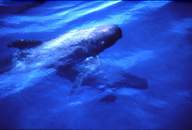|
A new treatment for T-cell acute lymphoblastic leukaemia? (09/2004)
IL-7, a hormone-like protein involved in cell-cell interaction, has been associated with increased survival and expansion of T-cell acute lymphoblastic leukaemia (T-ALL). Now, in the latest issue of the Journal of Experimental Medicine1, a team of scientists, not only confirms the essential role of this protein in the disease but also, for the first time, identifies the critical biochemical pathway affected by IL-7 in T-ALL cells, a discovery which could lead to the development of potential new treatments for the disease.
Leukaemia is a type of blood cancer which originates from an uncontrolled growth of abnormal cells in the bone marrow (usually the white blood cells/lymphocytes). This results in very little space left for the growth of normal cells which leads to a weakened immune system. In the case of acute leukaemia the filling of the bone marrow space is extremely fast and the disease needs immediate treatment or the patient will die.
Leukaemia affects 4 out of every 100,000 people worldwide and is the most common childhood cancer. In the United States alone, every year, more than 2,000 children and almost 27,000 adults are diagnosed with the disease.
Cytokines, such as IL-7, are powerful chemical substances secreted usually, but not only, by the immune system to transmit information/instructions between cells. IL-7 is a potent growth factor for immune cells and is indispensable for normal T-cell development. Several studies have also suggested that IL-7 was involved in T-cell acute lymphoblastic leukaemia’s growth although there was no little information on the mechanism(s) behind this effect.
João Barata, Angelo Cardoso, Vassiliki Boussiotis and colleagues at the Department of Medical Oncology, Dana-Farber Cancer Institute, Harvard Medical School, Boston and at the Tumour Biology Unit, Institute of Molecular Medicine, University of Lisbon, Portugal studied T-ALL cells cultured in the presence of IL-7 trying to understand, not only the real importance of this cytokine in the disease, but also the biochemical mechanism through which IL-7 mediated its effect on T-ALL.
In this paper, the team of researchers describe how they identify, for the first time, the cellular pathway responsible for the effects of IL-7 in T-ALL cells (the pathway identified is called PI3K/Akt(PKB)), an information that can now help scientists in the search for new treatments for the disease.
Barata, Cardoso, Boussiotis and colleagues also discovered that IL-7 affects T-ALL metabolism, increasing energy production in T-ALL cells which results in increased cell division and, ultimately, tumour growth. The team of scientists found as well, that IL-7 presence induces an increase in T-ALL cell size. Interestingly, both phenomena have been previously associated with the induction of cancer.
These results confirmed the role of IL-7 in T-ALL growth and activation and led the team of scientists to suggest that this cytokine plays a major role in T-ALL biology which further highlights the unique importance of IL-7 as a potentially therapeutic target.
Barata, Cardoso, Boussiotis and colleagues write: ”Our results implicate PI3K as a major effector of IL-7-induced viability, metabolic activation, growth and proliferation of T-ALL cells, and suggest that PI3K and its downstream effectors may represent molecular targets for therapeutic intervention in T-ALL.”
Understanding the mechanism behind disease is the first step towards a better treatment with higher efficacy and fewer secondary effects. Leukaemia, like all cancers, is still mostly treated by chemo- and radio-therapy treatments which destroy both cancerous and healthy cells and any alternative therapy that can replace or at least supplement these extremely invasive and not always effective treatments is always good news for patients and doctors alike.

1 J. Exp. Med. (2004) Vol. 200, pp. 659-669.
"Activation of PI3K Is Indispensable for Interleukin 7–mediated Viability, Proliferation, Glucose Use, and Growth of T Cell Acute Lymphoblastic Leukemia Cells”
Original paper’s authors
Link to the original paper
|
In collaboration with the Observatório da Ciência e do Ensino Superior (OCES)
Financed by the Fundação para a Ciência e Tecnologia (FCT) |





